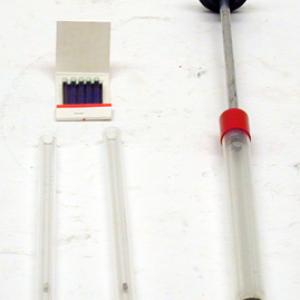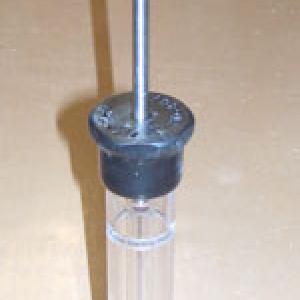College of Liberal Arts & Sciences
4B70.10 - Fire Syringe
Cut the match head off a paper match and insert it into the heavy glass tube of the fire syringe. Insert the plunger into the tube and put this assembly into the safety cylinder and rubber stopper pad. Darken the room and HIT THE PLUNGER VIOLENTLY!!!! The match head should flare when done properly. The most common mistake is not to hit the plunger hard enough to cause the very sudden pressure increase necessary to light the match. If you have fired the tube once and add another match head to the tube you must also blow in some new air (oxygen) or your results will be rather dismal.
WATCH OUT that the glass tube does not fall out the bottom of the safety assembly when carrying the unit around.
The PASCO unit is easier to use as the end cap screws out for reloading.
A very small bit of cotton will work in place of the match head. Experimentation will be needed to determine the proper amount. PRACTICE WILL BE REQUIRED!!!!
- Wheijen Chang, "Teaching the First Law of Thermodynamics via Real-Life Examples", TPT, Vol. 49, # 4, p. 231, April 2011.
- Carl H. Hayn and Scott C. Baird, "Adiabatic Compression in a Fire Syringe", TPT, Vol. 23, # 2, Feb. 1985, p. 101 - 102.
- He- 5: Freier and Anderson, A Demonstration Handbook for Physics.
- H-179: Richard Manliffe Sutton, Demonstration Experiments in Physics.
- George M. Hopkins, "Force of Stream", Experimental Science, p. 195.
- Theodore Gray, "Hot Under Pressure", Popular Science, April 2010, p. 76.
- W. Bolton, "The Expansion and Contraction of a Gas", Book I - Properties of Materials, Physics Experiments and Projects, 1968, p. 43.
- W. Bolton, "The Expansion of Air", Book I - Properties of Materials, Physics Experiments and Projects, 1968, p. 44.
- "Fire Syringe", Pike's Illustrated Catalogue of Scientific & Medical Instruments, Pike's Illustrated Descriptive Catalogue of Optical, Mathematical, and Philosophical Instruments, 1984, p. 95.
Disclaimer: These demonstrations are provided only for illustrative use by persons affiliated with The University of Iowa and only under the direction of a trained instructor or physicist. The University of Iowa is not responsible for demonstrations performed by those using their own equipment or who choose to use this reference material for their own purpose. The demonstrations included here are within the public domain and can be found in materials contained in libraries, bookstores, and through electronic sources. Performing all or any portion of any of these demonstrations, with or without revisions not depicted here entails inherent risks. These risks include, without limitation, bodily injury (and possibly death), including risks to health that may be temporary or permanent and that may exacerbate a pre-existing medical condition; and property loss or damage. Anyone performing any part of these demonstrations, even with revisions, knowingly and voluntarily assumes all risks associated with them.

